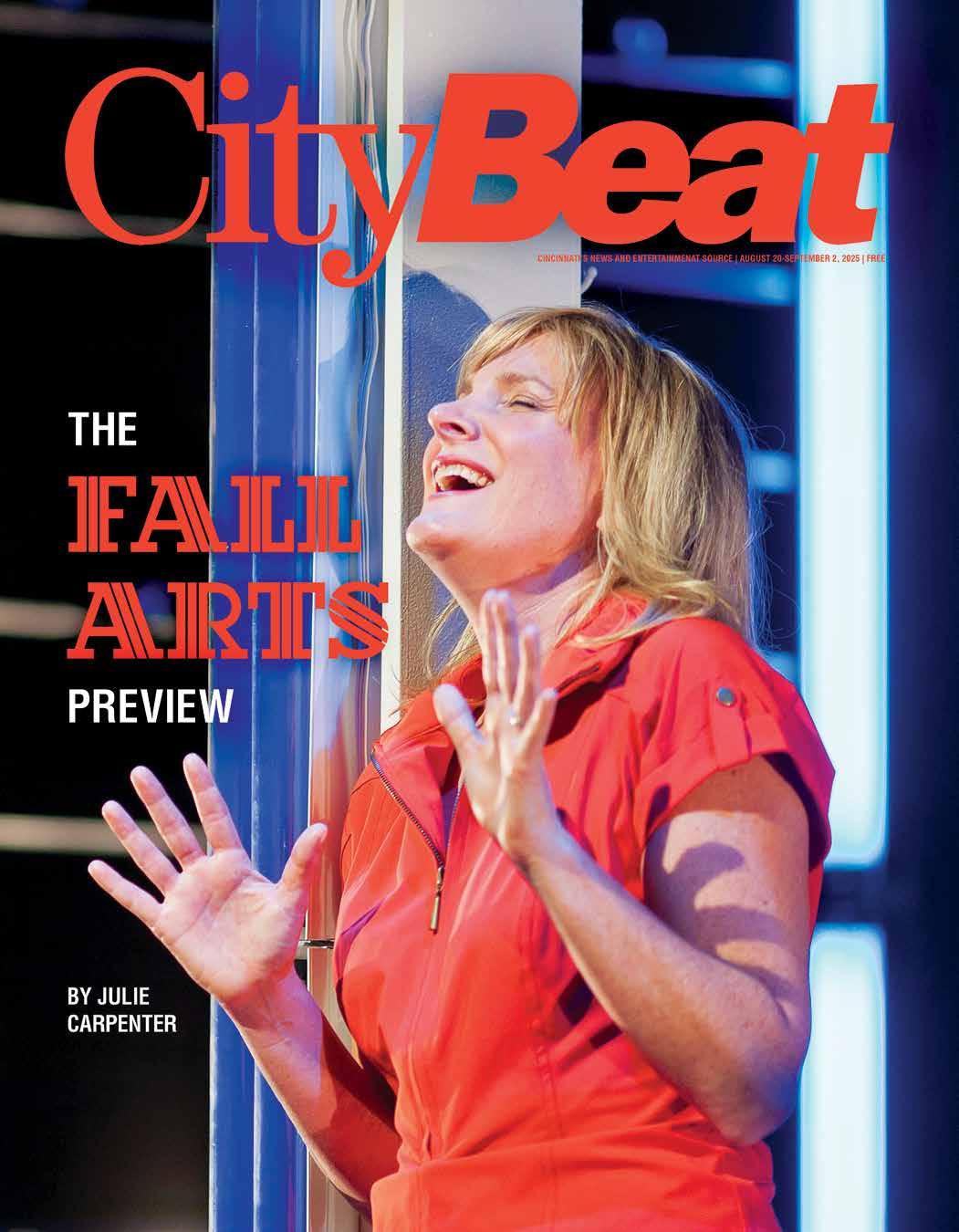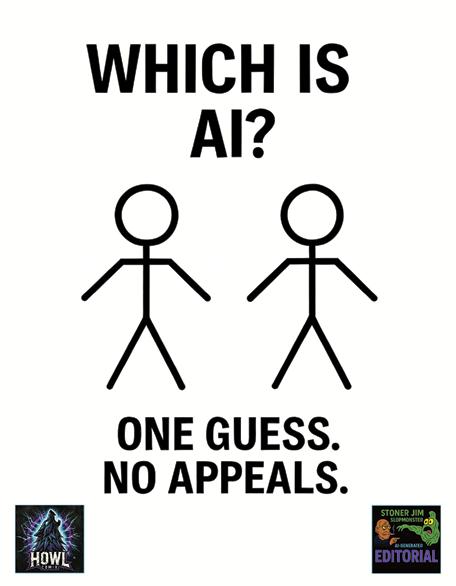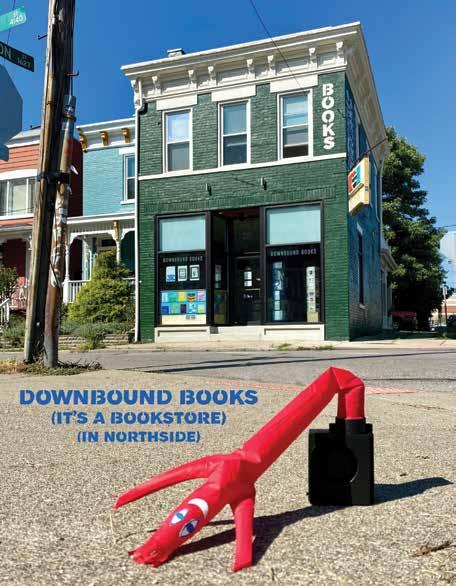




















Ayman Soliman cannot be transferred out of Ohio for another 14 days, but his legal team is still working to free him entirely.
BY MADELINE FENING
Afederal judge again has ruled that Imam Ayman Soliman can remain in Ohio for at least two more weeks, a spokesperson for Ohio Immigrant Alliance tells CityBeat.
The Temporary Restraining Order, or TRO, was first issued on July 30 by U.S. District Judge Jeffrey P. Hopkins; he granted another 14-day TRO on Aug. 13. Without the order, Soliman’s lead attorney Robert Ratliff said the Department of Homeland Security (DHS) has the authority to relocate him “literally anywhere.”
“Could be anywhere from Louisiana to Guantanamo to Alligator Alcatraz to Sudan,” Ratliff said during a July press briefing. “This could change the jurisdiction of the immigration court, which could delay his immigration proceedings, resulting in longer periods of detention.”
Ayman Soliman, who has no criminal record, has been held in the Butler County Jail since a July 9 check-in at the Homeland Security Office in Blue Ash ended in his arrest. The former journalist was granted asylum status in 2018 and worked as a chaplain at Cincinnati Children’s hospital. That status was revoked in June with Department of Homeland Security (DHS) officials claiming he had ties to a foreign terrorist organization. International experts and Soliman’s lawyers have pushed back on the designation.
The extended order also allows Soliman’s legal team to see through a newly filed lawsuit demanding his immediate release.
On Aug. 7, lawyers for Soliman announced a new federal habeas petition to release Soliman from the Butler County Jail, saying he was
unconstitutionally placed in solitary confinement in early August. According to legal filings provided to CityBeat, Soliman’s attorneys claim this placement was “a result of targeted harassment due to [Soliman’s] attempt to practice his religion.”
Kate Brady, one of Soliman’s attorneys with Muslim Legal Fund of America, said the solitary confinement was punishment for voicing disagreement with a guard over religious congregation space.
“He was asking to congregate with some of the inmates — I think to pray or to have maybe even a religious discussion — and he wanted to have it in a specific room,” Brady told CityBeat “I’d have to go back and look to see which one it was — let’s just say it was the common room, and he was told he couldn’t do that. He wasn’t satisfied with that, and I guess that particular corrections officer did not like that he did not just take his answer. That conversation ensued, and from that, he was placed in solitary.”
Lawyers claim the solitary confinement lasted from Aug. 2 until Aug. 5. Nazly Mamedova, another attorney for Soliman, said he hardly slept during this period.
“Ayman has not slept for more than 3 hours a day since he was locked up in solitary confinement,” said Nazly Mamedova, one of Soliman’s attorneys. “While he tried to keep a clear mind, he really struggled with being confined in a small space for 23 hours a day. Anyone would. The fact is, Ayman should be home doing the job that he loves and is good at, caring for others, not locked up in any jail cell.”
According to the court filing, Soliman was denied access to visitors during the four-day period in solitary confinement. Phone calls, including with his lawyers, were allegedly limited to a one-hour

window between 12 a.m. and 1 a.m.
Brady believes the jail is using solitary confinement as a tool to slow down her client’s legal defense.
“The Butler County Sheriff, under the color of DHS authority to detain people in removal proceedings, unlawfully uses solitary confinement to prevent attorneys’ access to their clients, which limits their ability to vigorously fight against the government’s deportation machine,” Brady said.
The Butler County Jail did not immediately respond to CityBeat’s request for comment on the petition.
Soliman fled to the U.S. from Egypt in 2014, according to immigration advocates at Ignite Peace Cincinnati. Soliman has said he was “escaping death” when he left his family in Egypt more than a decade ago. Soliman was reportedly jailed as a freelance journalist for his coverage of events related to the Arab Spring, according to the American Civil Liberties Union of Ohio. While in jail, the Muslim Legal Fund alleges he was “beaten and tortured for days at a time.” He applied for asylum status in 2015 and was approved in 2018. He then filed for his wife and child to join him in the U.S. under the same asylum case. He also applied for a green card shortly after being granted asylum; that application remains pending.
But in June 2025, Soliman’s asylum status was officially revoked after federal authorities started looking into his case in December 2024. Before Soliman’s July 9 arrest, advocates said he was extensively questioned by immigration and other federal authorities about his political affiliations.
In 2021, Soliman discovered there was an “FBI flag” on his record when he was offered a position at the Oregon Department of Corrections (ODOC) as an Islamic chaplain in 2021. His first background check showed an FBI flag, which caused the Department of Corrections to take back the job offer. Soliman sued the FBI and the Terrorist Screening Center in 2021, claiming his fingerprints did not match prints in the government’s terrorism screening database.
In Soliman’s most recent lawsuit filed against the federal government regarding the termination of his asylum status, he argues the government revoked his asylum due to past ties with the group Al-Jameya al Shareya (also written as AlGam’iyya al Shar’iyya) when he lived in Egypt. Soliman said his involvement as a board member of the organization was disclosed to DHS when he was granted asylum. The U.S. government alleges Al-Jameya al Shareya supported the Muslim Brotherhood, which Egypt has called a terrorist organization. International experts and Soliman’s lawyers have pushed back on the designation.
“Al-Jameya al Shareya is not a terrorist group,” Soliman’s legal team said in July. “It is a nongovernmental organization that provides medical services and charitable community services. Neither the U.S. government nor the Egyptian government has designated AGS/AJS a terrorist group.”
Soliman’s case has garnered
widespread attention and support from local leaders and community members, including many faith leaders in the Cincinnati area. After immigrating to the U.S., Soliman became a board member for the Clifton Mosque, the Islamic Association of Cincinnati and the Initiative on Islam and Medicine. According to his bio on the Clifton Mosque’s
website, Soliman holds undergraduate degrees in Islamic studies, Qura’n and Islamic Da’wah. He holds a Master’s degree in Islamic Studies and is currently pursuing a Master’s of Divinity in Islamic Studies and Muslim Chaplaincy, as well as a PhD in Islamic Studies.
Tala Ali, chairperson of the Clifton Mosque and the Islamic Association of
Cincinnati, addressed reporters alongside several community advocates just hours after Soliman’s arrest. She said Soliman serves families of all faiths in the Cincinnati community.
“He not only serves Muslim families, but families of all backgrounds and faiths,” she said. “He holds presence and pastoral care for all people.”
BY AVERY PADGETT
An old closed case, two arrests and a dead city commissioner — these are the basics of a true crime documentary in the making titled Our Friend Sandy from independent filmmakers Paul Nocchi and Louie Meisner, a Cincinnati native. As they start to dig through police records and dusty boxes in attics, they begin their race against time to tell the story of Harold “Sandy” Cohen and the circumstances surrounding his 1986 murder before the details are lost with the generation that remembers them.
Cohen, a first-generation Jewish immigrant, moved to Covington from Mississippi in 1978. As the city commissioner and the owner of a print shop, Cohen was well-known and, according to Meisner, beloved by the community. Meisner’s father, David, was even one of Cohen’s friends.
“He put his desk right in front of the window because he would wave at everybody walking by the window,” Meisner told CityBeat. “And that’s the kind of person he was.”
But after Cohen’s disappearance on July 5, 1986, and the subsequent discovery of his body five days later in Cincinnati, the case and his name quickly started to fade.
“In this small town back in the ‘80s, there was this really close-knit group of people, and that includes people in politics [and] law enforcement, who all have a relatively fond memory of this person and who were impacted,” Meisner said. “And yet, after this huge event happened, there was a silence [...] It was dropped and then essentially never spoken [of] again.”
Cohen’s case was closed shortly after his death. Gregory Moore and James Messmer were charged with murder and all evidence points to their guilt, but Meisner still considers this case to be unresolved. He is searching for the intentions behind the actions and wants to make sure Cohen’s name doesn’t fade away.
“I want as many people as humanly possible to know that person’s name,” Meisner said.

Cohen’s case quickly became sensationalized as he was outed as a gay man who held a political office over the course of the investigation. The defense team in court was quick to blame his murder on his sexuality, claiming that “there was an accidental murder or accidental killing, because they were involved in some type of homosexual, deviant relationship,” according to Meisner. He said Covington at the time was “relatively progressive,” but it was still the ‘80s.
According to an archived article from the Cincinnati Post, a now-defunct daily newspaper, the defense planned on hiring an “expert on homosexuality and deviant sexual behavior” to testify and explain the “effects of such behavior.” This was despite the fact that the defendant, James Messmer, made no mention of Cohen’s sexuality being
a factor in the crime in his statement to police.
As the facts were warped and later forgotten, Meisner says there still wasn’t a concrete timeline — or even concrete facts — of the murder everyone can agree upon. Even David Meisner didn’t know the full story until recently, although it was Cohen’s friends who found his body.
“Up until maybe four months ago, my father was under the impression that his death had to do with some sort of accident happening in the car where his throat was accidentally crushed during a robbery gone wrong,” Meisner said.
Cohen had, in reality, been beaten and murdered. Meisner said his research revealed 16 skull fractures from blunt force trauma in Cohen’s autopsy.
Meisner acknowledges that “there’s only two people alive that actually know
exactly what happened,” but he wants this documentary to be about more than just Cohen’s death. He wants to uncover dusty letters and crumbling pictures to discover just who Cohen was to this town and these people before that information is lost to time.
“I guess I’m not really looking for a resolution in making people feel better, you know, there’s not a happy ending,” Meisner said. “I don’t really see an end to this outside of speaking to people [and] hearing the impact that he had.”
Production of the documentary Our Friend Sandy will start this coming fall, and the filmmakers are asking anyone with information about Cohen’s life or death to come forward.
“If there’s anybody that has any information or knows anything that isn’t public, please contact me or Paul or our organization,” Meisner said.



BY MADELINE FENING

Former U.S. Senator from Ohio Sherrod Brown is reportedly planning a run to reclaim his seat in 2026.
News of Brown’s plans to run was first reported by the Cleveland Plain Dealer and attributed to conversations Brown had with Ohio labor leaders about his plans. Brown, a Democrat, served in the Senate from 2007 to 2025, when Trumpbacked Republican Bernie Moreno defeated Brown by nearly 4 points, flipping the seat.
Brown’s candidacy is critical as Democrats need to gain four seats to reclaim Senate control. But as Politico points out, this will be tough: Only two of the 22 Republican seats up for grabs in the midterm elections come from states with foreseeable wiggle room.
Brown is the only major Democrat projected to run for the seat, which he’ll easily secure in a primary. Brown would face off against Sen. Jon Husted, Ohio’s former lieutenant governor. Ohio Gov. Mike DeWine appointed Husted to the Senate after JD Vance, a Middletown native, left the seat to become vice president.
Brown will run to replace Husted in finishing out Vance’s original term. He would need to run again in 2028 to win a full six-year term.
Brown reportedly considered a gubernatorial run after his 2024 defeat. As of press time, the most prominent Democrat in the race is former state health director Dr. Amy Acton, though former Ohio House minority leader Allison Russo and former U.S. representative Tim Ryan have expressed interest. On the Republican side, pharmaceutical tech CEO and former 2024 presidential candidate Vivek Ramaswamy is the front-runner, with Morgan County School Board member Heather Hill also in the race. Ohio lieutenant governor Jim Tres-
signaled interest in running.

BY JULIE CARPENTER

As the days grow shorter and the weather (hopefully) cools, it’s time to make those dinner reservations and book a sitter because the fall theater season is starting. With nearly two dozen companies and almost 30 productions to choose from this autumn, there’s a musical, play or revue for every theater fan, and plenty of opportunities for the theater curious to try something new.
The 2025-26 season starts strong for musical theater audiences of every
taste. There are classics and new works, and comedies and musicals of every style gracing stages this fall. Hairspray at the Warsaw Federal Incline Theater (Aug. 20-Sept. 14) goes back to the ‘60s with big hair and bigger songs to wrap up their summer season. The Carnegie celebrates the now-shortening summer nights with Grease (Aug. 15-24) featuring Paige Davis of Trading Spaces For fans of folkier music, Where the Mountain Meets the Sea at Cincinnati Playhouse in the Park (Aug. 30-Sept. 28)
uses music by The Bengsons to explore themes of love and family.
Cincinnati Music Theatre’s Studio Series starts with a musical revue, What Happens in Vegas, which features songs associated with Sin City (Sept. 5-13). For a dose of 1980s nostalgia, take a musical ride Back to the Future with Broadway in Cincinnati (Sept. 9-21).
Ensemble Theatre Cincinnati kicks off their 40th anniversary season with the Pulitzer Prize and Tony Award-winning rock musical Next to Normal (Sept.
13-Oct. 5) about a family’s struggle with a mother’s bipolar disorder. Mythic, a new pop-musical comedy comes to Playhouse (Sept. 20-Oct. 19), offering a reinterpretation of the Greek story of Persephone with the gods as pop stars and politicians.
Cincinnati Arts Association offers a show for the kiddos with Dog Man: The Musical, about a crime-fighting canine (Oct. 4-5). The Covedale Center for the Performing Arts starts its season of classic musicals with the matchmaking
antics of Hello, Dolly! (Oct. 9-Nov. 2).
Cinematic tearjerker turned musical The Notebook comes to Broadway in Cincinnati (Oct. 14-26) before they wrap up the year with a little show called Hamilton (Dec. 16-Jan. 4). Last, but not least, country music fans get a revue of their own with Because You’re Mine at Playhouse with love stories and songs about country greats Johnny Cash and June Carter, George Jones and Tammy Wynette, John Prine and Iris Dement, and more (Dec. 3-23).
It may be a surprise to musical lovers, but not everyone loves it when the cast breaks into song. Luckily, there are also plenty of plays in production this fall. Up the road in Dayton, The Human Race Theatre Company launches their 40th anniversary season with a world premiere comedy, Dad’s Place – A Farce (Sept. 3-14), about a writer helping his dad declutter. Mariemont Players kicks off their season with a romantic drama, The Rainmaker (Sept. 4-21). Cincinnati Shakespeare Company mixes classic and contemporary with Amy Herzog’s Tony Award-winning adaptation of Henrik Ibsen’s An Enemy of the People (Sept. 5-20) about the consequences of integrity.
Sports can compete for theatergoers’ time, but if you’re already disillusioned by fall football and longing for March madness, Know Theatre has the solution with King James, a comedy about basketball and LeBron James (Sept. 11-27). Cincinnati Playwrights Initiative starts their 30th anniversary season with the comedy road trip Hollywood Masala (Sept. 16). Across the river in Newport, Falcon Theatre opens its season with an off-beat comedy, The Secretary (Sept. 19-Oct. 4).
After back-to-back musicals, Playhouse stages The Heart Sellers, a moving new comedy (Oct. 25-Nov. 23) set during Thanksgiving 1973. Mariemont Players pivots to a thriller with I’ll Be Back Before Midnight (Nov. 6-23). Cincy Shakes’ production of Love’s Labour’s Lost (Nov. 14-Dec. 6) brings the Bard to the Breakfast Club with an ‘80s high school setting for this classic comedy. Cincinnati Playwrights Initiative features a night of four short plays — Thanks for Calling, Stillwater Depot, Center Street and Sgt Skinner Goes for Coffee — in the Kaplan Theater at the Aronoff (Nov. 18). Darkening days bring darker subjects as Falcon’s Lemons Lemons Lemons Lemons Lemons explores censorship (Nov. 7-22). If you’re interested in seeing the next generation of actors and performers before they take on local, regional and national stages, Greater Cincinnati universities are bringing the drama, singing and fun to college stages this fall. Northern Kentucky University kicks the student season off with the iconic
musical Oklahoma! (Sept. 26-Oct. 5) and wraps up 2025 with a trio of performances: the comedy play At the Wedding (Oct. 24-Nov. 2), an Emerging Choreographers’ Showcase (Nov. 23-24) and a First Year Showcase (Dec. 7-8). Xavier University students are featured in The 25th Annual Putnam County Spelling Bee, a musical comedy (Oct. 16-19), and in Arthur Miller’s classic play The Crucible (Nov. 14-22). At the time of writing, the University of Cincinnati’s College Conservatory of Music’s 2025-26 season has not been announced.
But wait! Where are the Halloween and Christmas shows? Surely, area theaters are doing something to celebrate those end-of-year holidays? They are! But you’ll have to wait for those dedicated previews coming soon to a CityBeat issue near you. Until then, get more information on the fall theater schedule and tickets by visiting theater websites.
Cincinnati Arts Association (Broadway in Cincinnati, Cincinnati Music Theater, and Cincinnati Playwrights Initiative): cincinnatiarts.org
The Carnegie: thecarnegie.com
The Children’s Theatre of Cincinnati: thechildrenstheatre.com
Cincinnati Playhouse in the Park: cincyplay.com
Cincinnati Shakespeare Company: cincyshakes.com
Covedale Center for the Performing Arts and Warsaw Federal Incline Theater: cincinnatilandmarkproductions.com
Ensemble Theatre Cincinnati: ensemblecincinnati.org
Falcon Theatre: falcontheater.net
The Human Race Theatre: humanracetheatre.org
Know Theatre of Cincinnati: knowtheatre.com/season-28
Mariemont Players: mariemontplayers.com
Northern Kentucky University: nku.edu
Xavier University: xavier.edu/theatre-program
University of Cincinnati’s College Conservatory of Music: ccm.uc.edu/onstage.html





Ra Ra Boom features four ninja cheerleaders fighting AI robots that forced humans to flee Earth.
BY KATHERINE BARRIER
What do you get when you take AI robots hellbent on destroying humans in an effort to save Earth and a group of four ninja cheerleaders adept at weaponry and blowing shit up? That would be Ra Ra Boom, the first game to come out of Cincinnati video game studio, Gylee Games.
Ra Ra Boom is a four-player co-op beat ‘em up game from this independent video game studio in Over-theRhine. Released on Aug. 12, the game’s story features four cheerleaders — Aris, Saida, Vee and Ren — who have grown up on a space station that orbits Earth after humans had to flee the planet 20 years prior. At the time, Earth tried utilizing AI to solve climate change, but the AI figured out the best way to save the planet was actually just to destroy all humans.
“So now, it’s 20 years later, and these girls have grown up in this environment, only in this space station. Earth is this mystery to them. And they think it’s this desolate, terrible place,” Chris Bergman, Gylee Games’ founder and CEO and the creator of Ra Ra Boom explains to CityBeat. “Something happens and they have to go back to Earth, and so this is them coming across this AI and this AI wanting to kill them, and then fighting their way through it and fighting robots — goofy robots.”
“Goofy” is key in the game. Despite
the post-apocalyptic setting, Ra Ra Boom’s world doesn’t look like a wasteland. The artwork is colorful and fun, designed to invoke the nostalgia of ‘80s and ‘90s Saturday morning cartoons. It’s bright and campy and created by hand using cel animation.
“We’re not trying to make a brown game; it’s not dreary, right?” Bergman says. “We wanted to have it feel like you’re playing a Saturday morning cartoon. That was really important to us.”
Ra Ra Boom’s gameplay is similar to the classic beat ‘em up games it was inspired by — games like Marvel vs. Campcom 2, X-Men and Teenage Mutant Ninja Turtles, which Bergman would play in the arcade at Northgate Mall after skipping school as a kid. Where the game differs from those, however, is its “badass all-female cast” —
“The only male in the game is a bad guy voiced by me, but not on purpose. We ran out of time and money,” Bergman laughs.
— and its narrative- and characterdriven focus.
“It’s a story about grief, a story about friendship, a coming-of-age story,” says Bergman. “We want you to experience the entire story. There’s a whole narrative there, and I think that’s really intentional for us. But we also wanted to create a universe where other games could live. Like, we’re very character-first before anything else, and we wanted to
tell a story about these characters that, hopefully, players fall in love with and want to hear more from.”
The game takes about four to six hours to complete, and it’s a co-op, meaning players work collaboratively instead of being pitted against each other. The choice was a nod to Bergman’s childhood spent in arcades.
“That’s where I made my friends was in these co-op beat ‘em ups, right? That’s where I could actually sit and talk and get to know somebody and be like, ‘Oh, what school did you skip from to be playing this game right now?’” he explains. “Arcades were really, like, this place where it was sort of my first church, like the place where I felt included and welcomed. … Our first game, I definitely wanted to pay homage to that influence that it had on me.”
And while most beat ‘em up games are typically focused on melee combat, like punching and kicking, Ra Ra Boom also offers the players the option of range combat, and the characters have their own weapons.
“Aris has her Uzis. Saida has a rocket launcher. And so, you can focus on those sorts of range combat instead of the melee — or both. So that’s another big differentiator for us,” says Bergman.
Another key feature of Ra Ra Boom that Bergman hopes players will enjoy is the soundtrack. Bergman partnered with his friend, Drew Marcum, a sound
designer and composer at Cincinnatibased Play Audio Agency, to create it. The duo formed a new EDM group called Toy District specifically for the soundtrack.
And not only is Ra Ra Boom the first game for Bergman’s studio, it’s the first game on the market that will feature the logo “Made in Cincinnati” when you fire it up.
“It’s the only game that you’ll see a ‘Made in Cincinnati’ logo, and this game is going out to 240 different countries in 13 languages. And they’re all going to see ‘Made in Cincinnati,’” Bergman says.
After six years of taking Ra Ra Boom from a concept that pushed Bergman to launch Gylee Games in the first place to a full-blown video game, it’s now available for players to experience and immerse themselves in the world and the stories of the characters Bergman helped create.
“I hope [players] fall in love with the characters. … I hope they just have fun,” Bergman tells CityBeat. “It’s meant to be really approachable. … anybody can play it. It’s meant to be light-hearted while emotional. I just really hope players enjoy it. And it’s a very optimistic game, and I think finding optimism in today’s world is challenging.”
Ra Ra Boom is now available for Xbox, PlayStation 5 and PC. You can learn more about the game at raraboom.




EATS
BY KATHERINE BARRIER
Arecently closed fine-dining restaurant in Hamilton is starting a new chapter.
Tano Bistro closed its Hamilton location in early July following what was supposed to be a temporary closure to fix a mechanical issue. But a few days later, the restaurant shared on social media that it would cease operations at the Marcum Park location.
“Since we opened in the summer of 2019, we have enjoyed serving our Hamilton patrons and being welcomed into the community. Throughout our time, we have tried to provide Hamilton with the highest quality dining experience, featuring delicious food and superior service,” the restaurant shared in a Facebook post at the time.
However, in early August, Tano Bistro announced that it would reopen the Hamilton location on Aug. 7, with some
changes, including new hours.
“Back in July, we closed our doors but we opened our minds to new possibilities. We needed to rethink our business. On August 7th, we start a journey to something different. Something special. Something great!” the restaurant wrote. “Please join us on this journey. Come for the food and service you’ve always enjoyed. Get ready for changes we think you’ll really like.”
Tano Bistro first opened its Hamilton location in 2019 in the Marcum apartment complex, offering a menu of seasonally inspired and chef-driven dishes. New operating hours for the Hamilton location are Tuesday through Saturday from 11 a.m. to 9 p.m. Guests can also visit its flagship location in Loveland.
Tano Bistro, 204 W. Loveland Ave., Loveland; 150 Riverfront Plaza, Hamilton. More info: foodbytano.com.
Support local restaurants and indulge in some delicious specials for Greater Cincinnati Restaurant Week this fall.
Restaurant Week returns MondaySunday, Sept. 22-28 with participating restaurants offering $26, $36, $46 and $56 three-course prix fixe menus. Along with meals, many restaurants will also offer seasonal-inspired cocktails made with Restaurant Week drink sponsors MadTree Brewing, Maker’s Mark, Saratoga Still
Water, and SWAY by MadTree. A dollar from every meal special served during Restaurant Week will go toward Cincinnati Children’s Hospital, and organizers will match the first 1,000 meals served by donating $1 per meal. Funds go toward families whose insurance doesn’t cover the cost of treatments, research and growing in-demand programs. Restaurant Week has raised more than $100,000 in the last five years to support these initiatives. To prepare for Restaurant Week,


you can download the official app. The app will allow you to plan your meals and check in to participating restaurants and track your meals to earn you points. The more you eat, the more points you earn. You’ll also earn extra points if you try a restaurant’s drink special. And if you earn enough points, you may just win a grand prize. Some restaurants participating include, but are not limited to:
• Artemis
• Coppin’s
• Golden Lamb
• Greyhound Tavern
• Nicola’s
• Primavista
• Ripple Wine Bar
• Truva Turkish Kitchen
More restaurants will be announced on Restaurant Week’s website, but restaurants are subject to change.
Learn more at greatercincinnatirestaurantweek.com.
After a long wait, a popular restaurant and bar known for its tongue-in-cheek menu and boozy drinks is opening another location in Cincinnati.
Ohio-based HangOverEasy has been serving breakfast, brunch and lunch dishes with saucy names like Sloppy Seconds and Walk of Shame, as well as brunch cocktails like mimosas and Bloody Marys, since it opened in Corryville in 2014. Now, a couple of years after its sign was first spotted in a Mt. Lookout storefront, the restaurant will soon be opening at 1000 Delta Ave.
“The new Mount Lookout location brings the same bold and boozy energy as the original Clifton location, but with an elevated twist,” the restaurant said in a
press release. According to the release, the restaurant on Delta will feature upgraded decor and finishes, plus new dishes like Crème Brûlèe Waffles, the Dirty Sanchez and Silence of the Hams, and says the flavors are just as wild as the names. While a grand opening date has not been announced, the restaurant hosted a private sneak peek for media in early August. HangOverEasy says, once open, the restaurant and bar’s operating hours will be from 7 a.m. to 3 p.m. Monday through Friday and from 8 a.m. to 3 p.m. Saturday and Sunday.
HangOverEasy, 13 W. Charlton St., Corryville; opening soon at 1000 Delta Ave., Mt. Lookout. More info: hangovereasy.com.

Caamp returns to Cincinnati with a new album and a deeper sense of home
BY ASHLEY MOOR
The Ohio boys are bringing their beautiful noise to Cincinnati.
On Aug. 24, Columbus-based band Caamp will be playing the only Ohio show on their current tour at the ICON Festival Stage at Smale Park.
Since the band released their debut album in 2016, their poignant descriptions of growing up in Ohio have been a major part of their music and identity — so much so that their unofficial band tagline is “Ohio Boys Making Beautiful Noise.”
Evan Westfall, Caamp’s co-founder and multi-instrumentalist, admitted that there is a bit of added pressure performing their music in front of local crowds.
“It’s like, even though there are people there who love you unconditionally, there’s still — at least for me personally — pressure to put on an even better show, especially when you always want to make longtime friends and family in the crowd proud,” Westfall told CityBeat
Caamp was formed by Westfall and lead singer and songwriter Taylor Meier, who met at an Upper Arlington summer camp in middle school. Meier began playing music in coffee shops around Athens in 2013 while attending Ohio University. They later acquired three more
band members: Joe Kavalec, Matt Vinson and Nick Falk.
In 2016, Caamp released their debut, self-titled album on Square Roots
Records — a raw, Americana effort with moving songwriting and sparse instrumentation. Their second full-length effort, 2019’s By and By, is a warm, homespun meditation on love, longing and the places that shape us — from quiet porches and winding backroads to moonlit nights under wide-open skies.
The songs are steeped in vivid, tactile moments; you can almost feel the summer air and smell the campfire smoke as the banjo strums on.
By and By helped secure Caamp’s debut on the Billboard Emerging Artists chart in 2019. The album also debuted at number one on the Heatseekers Albums chart. The band gained even more attention for their 2022 album, Lavender Days, when former President Barack Obama included a song from the album, “Apple Tree Blues,” on his 2022 summer music playlist. That same year, Caamp was also nominated for 2023 Duo/Group of the Year by the Americana Music Association. In June, Caamp released their fourth studio album, Copper Changes Color, which made it apparent from the louder,
said. “They kind of are folk songs at the heart of it. If you shifted back and made it an acoustic guitar or banjo record, it would be there … It’s not the sound that we were known for, for the first couple years. We were off the road for a while, and we were trying to figure out how to fall back in love with making music and playing shows again, and so this is what was fun for us at the time. We’ve been having a lot more fun on the road this year.”
In early August, Ohio State University announced several updates to Ohio Stadium’s gameday experience — including pairing Caamp’s “Ohio” with an inspirational video played during the first half of games. Though not a traditional stadium banger, “Ohio” is full of pride for the state. “Football and tall trees, the autumn never ends, summer lovin / Ohio, treat me well,” Meier’s smoky, rich voice croons over a banjo and guitar.
Along with the rest of the band, Westfall is firmly embedded in the Midwestern music scene. In 2020, he co-founded Super Sport Records, an independent record label based in Columbus that releases music from surf, garage rock and power-pop in Ohio and throughout the Midwest.
upbeat opening track, “Millions,” that fans were on a slightly different sonic journey this time around — one steeped in indie rock influences.
“By that point, Taylor was really into The Strokes and has been now for a while,” Westfall said. “You know, we’ve all had our Strokes phases. So Taylor started bringing in some of those songs. It was, like, super fun for me, because I honestly love The Strokes too, and it was fun to try to make songs like that.”
“Mistakes,” “One True Way” (featuring Madi Diaz), “Porchswing” and “Drive” are also reminiscent of The Strokes’ minimalist brand of indie rock. The album also takes some unexpected — and welcome — detours, like “Waiting Up (For You),” a lively Southern rock romp.
For listeners who aren’t fans of change, though, there are stripped-back songs that harken back to Caamp’s early, banjofueled days. Amid the more fast-paced indie rock tunes, “Fairview Feeling” is especially soft and soothing. Caamp also stays true to their roots in “Ohio’s Ugly,” another soft, folksy love song that playfully calls out their home state for being “all fields.”
“I think at the heart of part of the record, it’s still us, you know?” Westfall
During breaks from touring with Caamp, Westfall also tends to another professional pursuit — a growing solo career. In January, Westfall released his debut solo album, Is This Our Exit, a unique instrumental journey that helped him sharpen his creativity and musical focus. Not only did the solo album help propel his own career, but it also gave him some fresh ideas to take back to his band members.
“It’s just really healthy for us to all kind of have our own outlets like that,” Westfall said. “I was able to experiment with different tunings on the guitar for my stuff, and I was really excited to show the [Caamp] guys some open tunings. One of the songs off the new record, ‘Shade,’ was one of those open tunings. I ran over to Taylor’s house one day [because] I wanted to show him the open tuning, and we sat down and ended up writing that song that day.”
The last time Caamp visited Cincinnati was to open for The Lumineers at Riverbend Music Center in 2022. Westfall, whose wife is originally from Cincinnati, says that he is excited to return to the Queen City.
“I love Cincinnati,” Westfall said. “I’m really excited. I’m serious. I don’t say that all the time; like, we’re long overdue to be playing in Cincy and I’m just very excited to get out there.”
Caamp plays the ICON Festival Stage at Smale Park on Aug. 24 at 7 p.m. The Sam Fribush Organ Trio and Maggie Halfman open for the band. More info: bradymusiccenter.com.





GARY CLARK JR. WITH SUZANNE SANTO
Aug. 25 • Andrew J Brady Music Center
So-called “guitar gods” used to dominate the rock landscape. Not so much these days. Esoteric, fleet-fingered noodlers like Polyphia’s Tim Henson just don’t possess the broader cultural juice of someone like Eddie Van Halen or even Steve Vai. Gary Clark Jr. is one of the few high-profile, contemporary guitarists to draw comparisons to the aces of yore. Yet the Texas native says he has no interest in reviving the era his favorites — players like Albert Collins, Jimi Hendrix and Stevie Ray Vaughn — helped to define. He’s more interested in seeing how that tradition can be injected into diverse genres.
Clark Jr. grew up in Austin, an epicenter of guitar-centric music often highlighted by his favorite TV show, Austin City Limits. He was fascinated by the guitar from the get-go, eventually emerging as an heir to his heroes.
“I quit caring about what people thought about me wanting to be a certain thing,” Clark said of the comparisons in a 2024 interview with Grammy. com. “I think that being compared to Jimi Hendrix is a blessing and a curse for me, because I’m not that. I will never be that. I never wanted to imitate or copy that, no disrespect. You’ve got to find your own thing. And my own thing is incorporating all the styles of music that I love.”
For proof, see 2024’s JPEG Raw, Clark Jr.’s fourth and most eclectic set of songs yet. The title track sounds like something enduring hip-hop crew The Roots might conjure, mixing a heavy, snaredriven bottom end with piano and tasty guitar textures as Clark Jr. sings/raps about staying grounded amid outside expectations for both himself and his children: “My daughters ain’t gotta shake hips to make tips/No judgement, if it makes cents, it makes sense/But I ain’t with the ratchet, only racket they’ll be havin’/Is if they pick up a good habit where their name is on the bracket.”
The genre jumping continues with the slow-burning soul jam “Alone Together,” which features the mood-altering trumpet of Keyon Harrold, and the slinky funk rock of “What About the Children,” a duet with Stevie Wonder that’s as topical as it is ass moving. Expect a heavy dose of JPEG Raw to populate Clark Jr.’s current live set — a career-spanning journey mapping the guitarist’s move from upstart to savvy veteran.
Gary Clark Jr. and Suzanne Santo play

the Andrew J Brady Music Center on Aug. 25 at 7:30 p.m. More info: bradymusiccenter.com. (Jason Gargano)
Babe, has not only released DiFranco’s 23 studio albums but also artists who likewise use a folk base to relay their particular creative visions: Andrew Bird, Bitch and Animal, Anais Mitchell, Utah Phillips, Toshi Reagon and Dar
Righteous Babe to disseminate her view of the world. The Buffalo, New York, native was especially busy in the 1990s, delivering 10 full-length albums during the decade, a whirlwind of writing, recording and touring that didn’t shy away from highlighting her political and social beliefs at a time when being an opinionated bisexual woman wasn’t the norm.
“These records that I made all on my own are an acquired taste,” DiFranco said in an interview earlier this year with The Guardian. “I’m not an expert recordist, mixer, producer. I have regrets about not doing a lot of my songs justice along the way. It’s just a matter of what I can afford, operating on the level that I am. There are sacrifices to being outspoken and political. I’ve been pushed down and reduced because of my feminism, etcetera. But anything worthwhile involves sacrifice.”
DiFranco’s most recent album, 2024’s Unprecedented Shit, features 11 songs over 37 minutes, each tune an exploration of its creator’s unique headspace three decades into a career that shows no signs of slowing. “Baby Roe” is the most sonically intriguing of the new material; it opens with jittery synths, rhythms and acoustic guitar backing DiFranco’s expressive sing/ speak vocals before exploding at the chorus with thundering drums as she bellows, “The path of least suffering/ Leaves the best trail/The path of least suffering/It don’t matter which side of the veil.” Given the song’s title, the matter at hand seems to be the current

